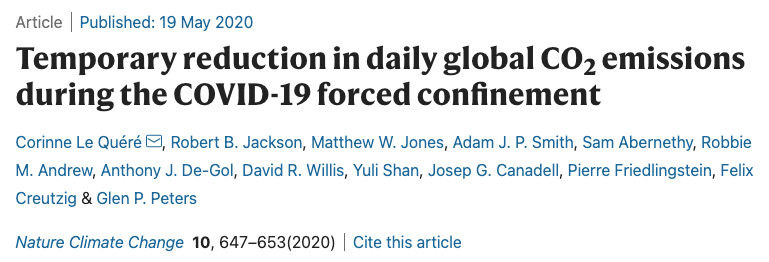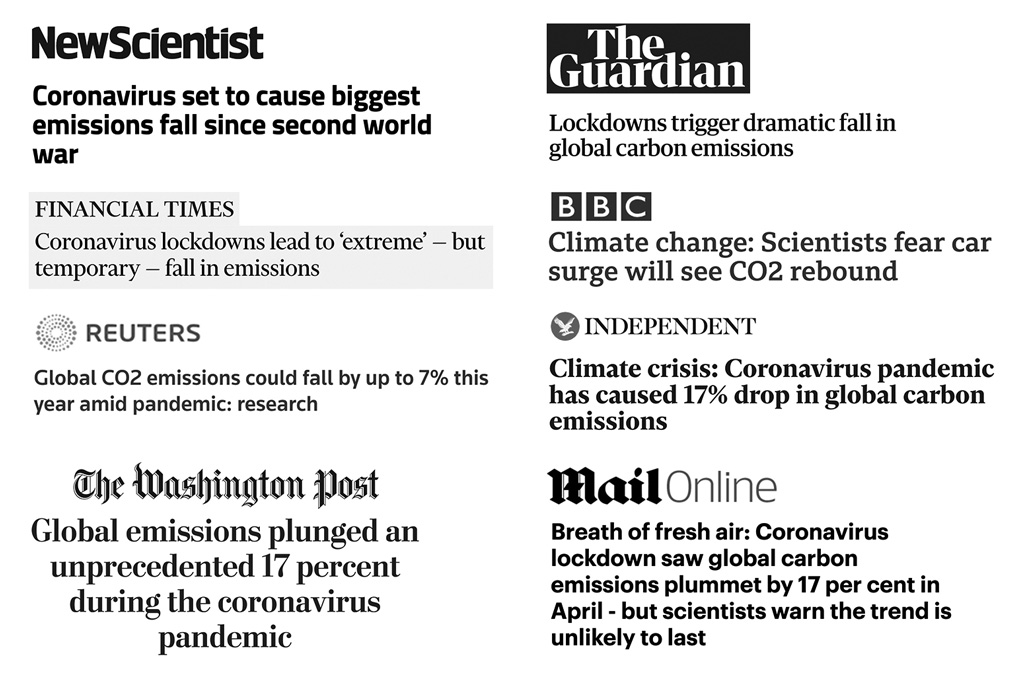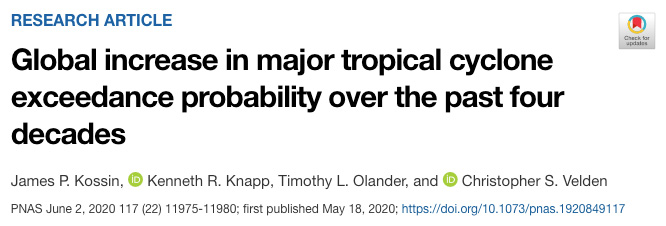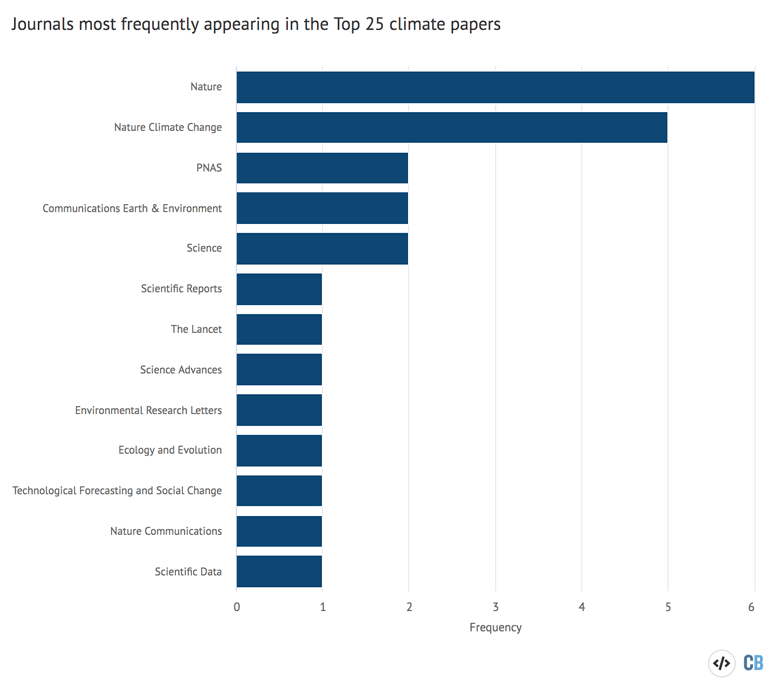Robert McSweeney
13.01.2021 | 11:07amLast year was meant to be very different. The lead up to the fifth anniversary of theParis Agreementwasmarkedoutbymanyas theyear for climate action. Indeed, 2020 followed a year where climate change had beenpropelled onto newspaper front pagesby Greta Thunberg, school strikes and Extinction Rebellion.
But, as with many aspects of 2020, the Covid-19 pandemic soon took centre stage.
As normal life was turned upside down, newspaper headlines and social media conversations were dominated by lockdowns, vaccines and infection rates.
Yet there was still space to report on climate change. And thousands of newly published peer-reviewed climate papers vied for media attention throughout the year.
These studies were covered around the world in news articles and blogs. They were also shared on social media platforms, such as Twitter, Facebook and LinkedIn.
Tracking all these “mentions” wasAltmetric, an organisation that scores and ranks papers according to the attention they receive. (Full details of how the Altmetric scoring system works can be found in anearlier article.)
Using Altmetric data for 2020, Carbon Brief has compiled its annual list of the 25 most talked-about climate change-related papers that were published the previous year. The infographic above shows which ones made it into the Top 10, while the chart at the end of the piece shows which journals feature most frequently in the Top 25.
Top spot in a Covid year
Last year was truly extraordinary for press and social media attention of scientific journal papers.
In the six years that Carbon Brief has been undertaking this annual review,2018was the first year where a paper – on any topic – hit an Altmetric score of more than 10,000. In2019, Altmetric found two papers that passed this milestone.
The year of 2020 had 60. And all but a few were about Covid-19.
(For Carbon Brief’s previous Altmetric articles, see the links for2019,2018,2017,2016and2015.)
It is, perhaps, no surprise then that the top climate paper of 2020 was also about Covid-19. It was the Nature Climate Change paper, “Temporary reduction in daily global CO2 emissions during the Covid-19 forced confinement”, byProf Corinne Le Quéré, a Royal Society research professor of climate change science at theUniversity of East Anglia, and colleagues.

The study estimated that the amount of CO2 being released by human activity each day fell by as much as 17% during the height of the coronavirus crisis in early April. It also forecasted that CO2 emissions for the year as a whole would drop by 7.5% compared to 2019. (A forecast that would prove to bevery closeto an estimate at the end of the year.)
In addition tocovering the study, Carbon Brief also hosted awebinaron the impact of the Covid pandemic on CO2 emissions, with Le Quéré as one of the panellists.
The paper clocked in with an overall Altmetric score of 6,174. It was mentioned in 715 online news stories by 398 outlets, in 109 posts from 63 blogs, and in more than 4,000 tweets – the most of any climate paper published last year for these categories.
In widespread news coverage, the study was covered by theWashington Post,Financial Times,Reuters,New Scientist,Guardian,BBC News,Independent,MailOnlineandSky News.

In another example of 2020 being such a remarkable year, this top climate paper is the 140th highest ranking of all papers scored by Altmetric. By comparison, in 2019, the top-ranked climate paper was theseventh highest overall.
(Update: Altmetric has now published itsTop 100 papers for 2020. It ranks the Le Quéré et al. paper in 12th place. The higher ranking is because Altmetric changed their methodology this year – rather than taking the 100 highest-scoring papers, they have selected the five top-scoring papers across 20 categories to give them a Top 100.)
Second place
The next highest scoring climate paper of 2020 was a short “News & Views” piece called “Record-setting ocean warmth continued in 2019”, published in Advances in Atmospheric Sciences, with a score of 3,954.
The paper presents new ocean heat content data, which revealed that “the world’s oceans in 2019 were the warmest in recorded human history”.
However, because the paper is an invited commentary rather than a traditional research paper, it isn’t included in Carbon Brief’s leaderboard.
(Commentaries are typically commissioned by journal editors, rather than being part of an open submission process. They are also not routinely peer-reviewed. Carbon Brief does include review and perspective articles in the leaderboard, however, as these tend to follow a more traditional editorial process, though this varies by journal. For more on the different types of journal articles, see the guidelines given byNatureand亚慱彩票APPas examples.)
Instead, taking second spot with an Altmetric score of 3,696 is “Future of the human climate niche”, published in the Proceedings of the National Academy of Sciences (PNAS). Its lead author isDr Chi Xu, an ecologist atNanjing Universityin China.
The study shows that, for thousands of years, “humans have concentrated in a surprisingly narrow subset of Earth’s available climates, characterised by mean annual temperatures around 13C”. It warns that between one and three billion people could be left outside this “environmental niche” in the next 50 years, depending on the rate of warming and population growth.

The paper was covered by 229 online news stories from 175 outlets across the world, including theNew York Times,USA Today,CNN,Guardian,BBC News,Independent,Sun,Times of India,South China Morning PostandDer Spiegel. It was also picked up by 37 posts from 29 blogs and tweeted more than 3,000 times.
In a piece for theConversation,University College London’sProf Mark Maslindescribed the study as a “brilliant thought experiment”, but highlighted some reservations, including a focus on a “worst case scenario” of climate change and not taking into account of the “dynamic and adaptable nature of human technology and society”.
Third place
Taking the final place on the rostrum is “Global increase in major tropical cyclone exceedance probability over the past four decades”, with an Altmetric score of 3,669.
The study finds that major tropical cyclones –category 3 or higher– have become 15% more likely at a global level between 1979 and 2017.
The North Atlantic has seen the most significant increases in cyclone intensity, the study says, with the chances of a major hurricane occurring in the North Atlantic increasing by 49% per decade.

Back in May, lead authorDr James Kossin, a climate scientist at theNational Oceanic and Atmospheric Administration(NOAA)Center for Weather and Climate, told亚慱官网:
“Our analysis finds that the global increasing trend in tropical cyclone intensity has now risen to a point where it is very unlikely to be random, even after addressing known issues with the historical data.”
The study featured in 739 online news articles from 405 outlets, including theNew York Times,Washington Post,New Scientist,CNNandUSA Today. It was covered by 50 posts from 37 blogs and was tweeted 549 times – the smallest total of any paper in this Top 10.
(There is also a second study on tropical cyclones in the Top 25. In the 25th and final place is the Nature paper “Slower decay of landfalling hurricanes in a warming world”, which finds that landfalling hurricanes are now taking longer to weaken as they move inland than they were 50 years ago.)
Top 5
In fourth place is “Sandy coastlines under threat of erosion”, published back in March in Nature Climate Change, with a score of 3,065. The study was led byDr Michalis I Vousdoukas, a coastal oceanography researcher at the European CommissionJoint Research Centre.
The research, which uses satellite data, suggests that erosion driven by rising sea levels could cause “the near extinction of almost half of the world’s sandy beaches by the end of the century”.
Such a stark finding garnered widespread press and social media attention, including 358 news stories from 317 outlets, 23 posts from 19 blogs and more than 600 tweets. Outlets covering the study included theGuardian,i newspaper,Conversation,Sun,Associated Press,CNN,Sydney Morning HeraldandMailOnline.
In October, Nature Climate Change published a “matters arising” response to the paper, in which another group of researchers argue that the study’s headline finding is “incorrect and potentially damaging”.
They note that “sandy beaches are highly variable in form and setting, and it is widely accepted that there is no single response to sea level rise”. Shorelines will retreat as sea levels rise, but beaches “will survive”, they say, adding that “the biggest threat to the continued existence of beaches is coastal defence structures that limit their ability to migrate.”
However, in areply,original study authors say these statements “lack the evidence needed to substantiate them”. They warn that “there is the risk that coastal communities and managers are lulled into a false sense of security”.
Taking fifth spot is the Nature paper “Rebuilding marine life”, which accumulated an Altmetric score of 2,848. The review study “document[s] the recovery of marine populations, habitats and ecosystems following past conservation interventions”.
It concludes that “recovery rates across studies suggest that substantial recovery of the abundance, structure and function of marine life could be achieved by 2050, if major pressures – including climate change – are mitigated”.
The paper appeared in 208 news stories from 188 outlets, 18 blogs and more than 2,000 tweets. The finding that the world’s oceans could be restored within 30 years generated headlines in theGuardian,Press Association,BBC News,i newspaperandMailOnline, and was the subject of an editorial in theTimes.
The Top 10
只是错过啊n the Top 5 is “Dynamic ice loss from the Greenland Ice Sheet driven by sustained glacier retreat”, which is the first-ever article published in Nature’s new online journalCommunications Earth & Environment.
The research finds that retreating glaciers resulted in a “step-change” in Greenland ice sheet melt in the early 2000s and a “switch to a new dynamic state of sustained mass loss that would persist even under a decline in surface melt”.
(For more on the state of the Greenland ice sheet – and discussion of this study – see亚慱官网’s guest post from September.)
The study comes in with a score of 2,784. It featured in 274 news stories from 201 outlets, 48 posts from 37 blogs and more than 1,500 tweets. Among the outlets that covered the study wereReuters,CNN,Inside Climate News,Axios,Daily Express,ForbesandMailOnline.
(There is also another paper on Greenland in the Top 25, with “Return to rapid ice loss in Greenland and record loss in 2019 detected by the GRACE-FO satellites” in 16th place. The study, also published in Communications Earth & Environment, finds that 2019 saw the ice sheet hit a record annual loss of 532bn tonnes.)
In seventh place, with a score of 2,543, is the Nature paper “Temperate rainforests near the South Pole during peak Cretaceous warmth“. This study presents evidence that the parts of West Antarctica was covered with temperate rainforests during the mid-Cretaceous period – one of the warmest intervals of the past 140m years.
Landing in eighth place is another polar paper – “Fasting season length sets temporal limits for global polar bear persistence”. Published in Nature Climate Change and clocking up a score of 2,528, the research warns thatArctic sea ice declineis likely to seepolar bearsspend more time on land, increasing how long they are required to fast and putting their survival and ability to reproduce at risk.
In ninth position is the 2020 report of the Lancet Countdown on health and climate change, focusing on “responding to converging crises”, which has an Altmetric score of 2,468.
The annual report is the latest in a project involving 35 academic institutions and UN agencies from across the world, whichbegan in 2015. The 2020 report “tracks the relationship between health and climate change across five key domains and over 40 indicators”. Its executive summary warns:
“The changing climate has already produced considerable shifts in the underlying social and environmental determinants of health at the global level. Indicators in all domains…are worsening. Concerning, and often accelerating, trends were seen for each of the human symptoms of climate change monitored, with the 2020 indicators presenting the most worrying outlook reported since The Lancet Countdown was first established.”
Taking the final spot in the Top 10 is “The emergence of heat and humidity too severe for human tolerance” in Science Advances, with a score of 2,400. The study looks specifically at “wet-bulb” temperatures of more than 35C, which is considered to be the upper limit for the human body to “efficiently shed heat”.
Analysing weather station data from around the world, the researchers find that some coastal subtropical locations have already reported wet-bulb temperatures of 35C and “that extreme humid heat overall has more than doubled in frequency since 1979”.
Elsewhere in the Top 25
只是错过了十大科学佩普亚慱彩票APPr “Climate change contributes to widespread declines among bumble bees across continents”, with a score of 2,379. The study finds that more severe and frequent periods of extreme heat are contributing to the loss of bumble bees across North America and Europe.
As lead authorPeter Soroyetold thePress Associationwhen the paper was published:
“We found that populations were disappearing in areas where the temperatures had gotten hotter. If declines continue at this pace, many of these species could vanish forever within a few decades.”
In 12th, with a score of 2,224, is “Climate change is increasing the likelihood of extreme autumn wildfire conditions across California“. The study, published in Environmental Research Letters, finds that autumn days in California with “extreme fire weather” conditions have more than doubled since the early 1980s.
The timing of the paper’s publication in late August – during thestate’s devastating wildfires– likely contributed to its widespread media coverage. The paper featured in 300 news articles – the fourth highest number in the Top 25.
Looking a little further down the leaderboard, in 18th place is the Nature paper “Asynchronous carbon sink saturation in African and Amazonian tropical forests”, with a score of 1,992.
Study co-authorProf Simon Lewis, a professor of global change science atUniversity College Londonand theUniversity of Leeds, wrote a亚慱官网guest post about the research when it was published.
The findings, he explained, suggest that “the ability of intact tropical forests to remove CO2 from the atmosphere reached its peak in the 1990s and has since been in decline”.
In 19th is “Current and future global climate impacts resulting from Covid-19”, published in Nature Climate Change, with a score of 1,927.
The study finds that the temporary dip in global emissions will only prevent around 0.01C of warming. However, the world could avoid 0.3C of further warming by 2050 if governments invest in a strong “green recovery” from the coronavirus pandemic, the researchers say.
When the paper was published in August, lead authorPiers Forster教授– founding director of thePriestley International Centre for Climateat theUniversity of Leeds– told亚慱官网that the moment was “make or break” for global climate targets:
“之前我们有冠状病毒没有走上正亚博体育ios轨,我们absolutely weren’t…If we don’t do it today I think we won’t ever be able to, unfortunately.”
And, finally, towards the bottom of the Top 25 are a couple of papers on climate “tipping points” – thresholds where a small change could push a system into a completely new state. (For more on tipping points, see亚慱官网’s in-depth explainer.)
In 21st place is “Regime shifts occur disproportionately faster in larger ecosystems“, published in Nature Communications, with a score of 1,893.
这个模型研究发现,大型系统往往to shift more slowly than small systems but disproportionately faster. The study concludes:
“The findings imply that shifts in Earth ecosystems occur over ‘human’ timescales of years and decades, meaning the collapse of large vulnerable ecosystems, such as theAmazon rainforestand Caribbean coral reefs, may take only a few decades once triggered.”
And in 24th place, with a score of 1,831, is the Nature paper “The hysteresis of the Antarctic Ice Sheet”. The study identifies thresholds of ice loss from Antarctica according to levels of global warming.
For example, the researchers find that the ice sheet’s “temperature sensitivity is 1.3 metres of sea-level equivalent per degree of warming up to 2C above pre-industrial levels”, which almost doubles to “2.4C per degree of warming between 2 and 6C”.
这些阈值显示“磁滞行为”,the study says, which means that the ice sheet won’t necessarily regain the lost ice if global temperatures are reversed to present-day levels.
All the final scores for the Top 25 climate papers of 2020 can be found inthis spreadsheet.
Top journals
Across the Top 25 papers identified here, the journal that features most frequently is Nature, with six papers in total. Nature also took first, or joint first, spot in Carbon Brief’s Top 25 in2019,2018,2017and2015.
The next highest is Nature Climate Change with five papers represented. Then follows three journals with two papers each – PNAS, Communications Earth & Environment, and Science – and then nine journals with one paper in the Top 25.

Infographic by Joe Goodman for Carbon Brief.
Update: This piece was updated on 20/01/2021 to add a mention of Altmetric’s newly published Top 100 for 2020.
-
Analysis: The climate papers most featured in the media in 2020
-
Which climate-related journal papers made the biggest media splash in 2020?

